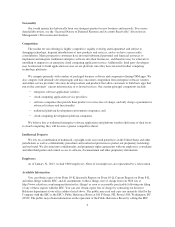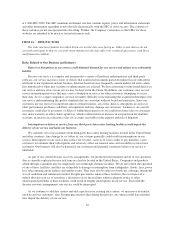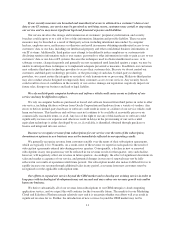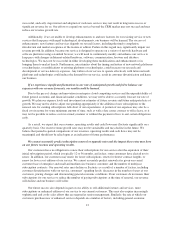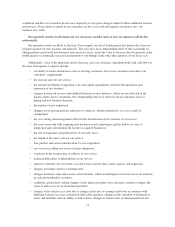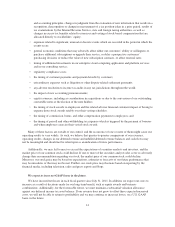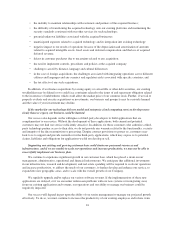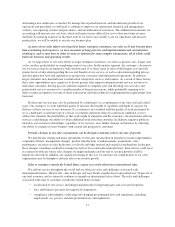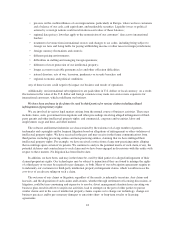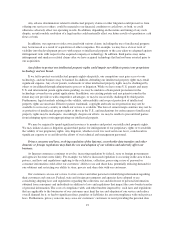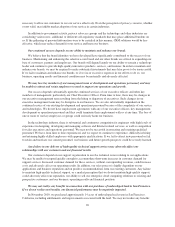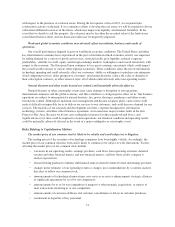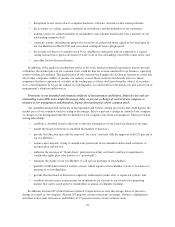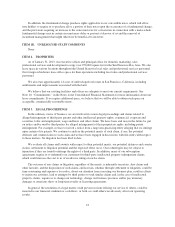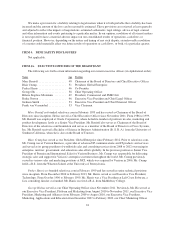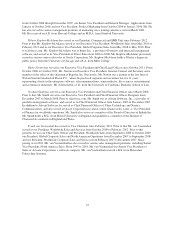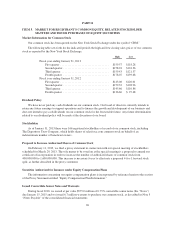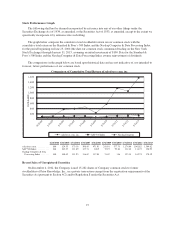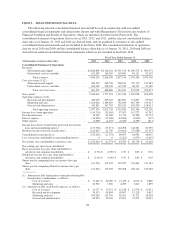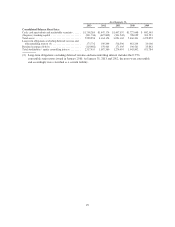Salesforce.com 2013 Annual Report Download - page 23
Download and view the complete annual report
Please find page 23 of the 2013 Salesforce.com annual report below. You can navigate through the pages in the report by either clicking on the pages listed below, or by using the keyword search tool below to find specific information within the annual report.Any adverse determination related to intellectual property claims or other litigation could prevent us from
offering our service to others, could be material to our financial condition or cash flows, or both, or could
otherwise adversely affect our operating results. In addition, depending on the nature and timing of any such
dispute, an unfavorable resolution of a legal matter could materially affect our future results of operation or cash
flows or both.
In addition, our exposure to risks associated with various claims, including the use of intellectual property,
may be increased as a result of acquisitions of other companies. For example, we may have a lower level of
visibility into the development process with respect to intellectual property or the care taken to safeguard against
infringement risks with respect to the acquired company or technology. In addition, third parties may make
infringement and similar or related claims after we have acquired technology that had not been asserted prior to
our acquisition.
Any failure to protect our intellectual property rights could impair our ability to protect our proprietary
technology and our brand.
If we fail to protect our intellectual property rights adequately, our competitors may gain access to our
technology, and our business may be harmed. In addition, defending our intellectual property rights may entail
significant expense. Any of our patents, trademarks or other intellectual property rights may be challenged by
others or invalidated through administrative process or litigation. While we have some U.S. patents and many
U.S. and international patent applications pending, we may be unable to obtain patent protection for the
technology covered in our patent applications. In addition, our existing patents and any patents issued in the
future may not provide us with competitive advantages, or may be successfully challenged by third parties.
Furthermore, legal standards relating to the validity, enforceability and scope of protection of intellectual
property rights are uncertain. Effective patent, trademark, copyright and trade secret protection may not be
available to us in every country in which our service is available. The laws of some foreign countries may not be
as protective of intellectual property rights as those in the U.S., and mechanisms for enforcement of intellectual
property rights may be inadequate. Accordingly, despite our efforts, we may be unable to prevent third parties
from infringing upon or misappropriating our intellectual property.
We may be required to spend significant resources to monitor and protect our intellectual property rights.
We may initiate claims or litigation against third parties for infringement of our proprietary rights or to establish
the validity of our proprietary rights. Any litigation, whether or not it is resolved in our favor, could result in
significant expense to us and divert the efforts of our technical and management personnel.
Privacy concerns and laws, evolving regulation of the Internet, cross-border data transfers and other
domestic or foreign regulations may limit the use and adoption of our solution and adversely affect our
business.
As Internet commerce continues to evolve, increasing regulation by federal, state or foreign governments
and agencies becomes more likely. For example, we believe increased regulation is occurring in the area of data
privacy, and laws and regulations applying to the solicitation, collection, processing or use of personal or
consumer information could affect our customers’ ability to use and share data, potentially reducing demand for
our solutions and restricting our ability to store, process and share data with our customers.
Our customers can use our service to store contact and other personal or identifying information regarding
their customers and contacts. Federal, state and foreign governments and agencies have adopted or are
considering adopting laws and regulations regarding the collection, use and disclosure of personal information
obtained from consumers and individuals in addition to laws and regulations that impact the cross-border transfer
of personal information. The costs of compliance with, and other burdens imposed by, such laws and regulations
that are applicable to the businesses of our customers may limit the use and adoption of our service and reduce
overall demand for it, or lead to significant fines, penalties or liabilities for any noncompliance with such privacy
laws. Furthermore, privacy concerns may cause our customers’ customers to resist providing the personal data
19


